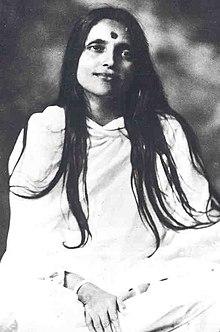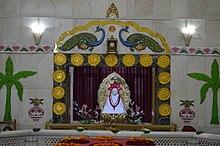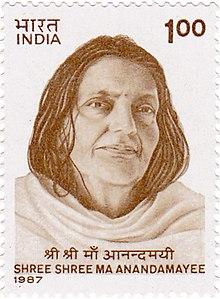Anandamayi Ma
Anandamayi Ma (née Nirmala Sundari; 30 April 1896 – 27 August 1982) was an Indian saint and yoga guru,[2] described by Sivananda Saraswati (of the Divine Life Society) as "la fleur la plus parfaite que le sol de l’Inde ait produite"[3] [the most perfect flower the Indian soil has produced].[4] Precognition, faith healing and miracles were attributed to her by her followers.[5] Paramahansa Yogananda translates the Sanskrit epithet Anandamayi as "Joy-permeated" in English. This name was given to her by her devotees in the 1920s to describe her perpetual state of divine joy [6]

Biography
Early life
Anandamayi was born Nirmala Sundari Devi on 30 April 1896 to the orthodox Vaishnavite Brahmin couple
Bipinbihari Bhattacharya and Mokshada Sundari Devi in the village of Kheora, Tipperah District (now Brahmanbaria District), in present-day Bangladesh.[6][1] Her father, originally from Vidyakut in Tripura, was a Vaishnavite singer known for his intense devotion. Both parents were from well regarded lineages, though the family lived in poverty. Nirmala attended village schools of Sultanpur and Kheora for approximately 2–4 months.[7] Although her teachers were pleased with her ability, her mother worried about her daughter's mental development because of her constantly indifferent and happy demeanour When her mother once fell seriously ill, relatives too remarked with puzzlement about the child remaining apparently unaffected.
In 1908 at the age of twelve years, 10 months, in keeping with the rural custom at the time, she was married to Ramani Mohan Chakrabarti of Bikrampur (now Munshiganj District) whom she would later rename Bholanath [7][8] She spent five years after her
Sri Anandamayi Ma
Personal
Born Nirmala Sundari[1]
30 April 1896
Kheora, Brahmanbaria District, Bengal Presidency, British Raj (present-day Bangladesh)

Died 27 August 1982 (aged 86)
Kishenpur, Dehradun, Uttarakhand, India
Religion Hinduism
Spouse Ramani Mohan Chakrabarti
Order Self-realization (Enlightenment)
Philosophy Tantra · Bhakti yoga
Studio photo of Anandamayi Ma
Ramna Kali Mandir in 1967
marriage at her brother-in-law's home, attending to housework in a withdrawn meditative state much of the time. It was at Ashtagram that a devout neighbour, Harakumar, recognised and announced her spiritual eminence, developed a habit of addressing her as "Ma", and prostrated before her morning and evening in reverence.[9]
When Nirmala was about seventeen, she went to live with her husband who was working in the town of Ashtagram In 1918, they moved to Bajitpur, where she stayed until 1924. It was a celibate marriage whenever thoughts of lust occurred to Ramani, Nirmala's body would take on the qualities of death.[10]
On the full moon night of August 1922, at midnight, twenty-six-year-old Nirmala enacted her own spiritual initiation [11] She explained that the ceremony and its rites were being revealed to her spontaneously as and when they were called for.[9] Although she was uneducated in the matter, the complex rites corresponded to those of traditional, ancient Hinduism, including the offerings of flowers, the mystical diagrams (yantra) and the fire ceremony (yajna). She later stated, "As the master (guru) I revealed the mantra; as the disciple. I accepted it and started to recite it."[12]

Dhaka
Nirmala moved to Shahbag with her husband in 1924, where he had been appointed as the caretaker of the gardens of the Nawab of Dhaka.[8] During this period Nirmala went into ecstasies at public kirtans [7] Jyotiscandra Ray, known as "Bhaiji", was an early and close disciple. He was the first to suggest that Nirmala be called Anandamayi Ma, meaning "Joy Permeated Mother", or "Bliss Permeated Mother". He was chiefly responsible for the first ashram built for Anandamayi Ma in 1929 at Ramna, within the precinct of the Ramna Kali Mandir.[13] In 1926, she reinstated a formerly abandoned ancient Kali temple in the Siddheshwari area.[8] During the time in Shahbag, more and more people began to be drawn to what they saw to be a living embodiment of the divine.[14]
Dehradun
From her shift Dehradun onwards various scholars were drawn to Anandamayi Ma's light, gift, power and message of love, though she continued to describe herself as "a little unlettered child" Prangopal Mukerjee (http://www.anandamayi.org/ma-anandamayis-letters/)[7]
Mahamahopadhyay Gopinath Kaviraj, Sanskrit scholar, philosopher, and principal of Government Sanskrit College in Varanasi and Triguna Sen were among her followers [8] Uday Shankar, the famous dance artist, was impressed by Anandamayi Ma's analysis of dance, which she used as a metaphor for the
 Anandamayi Ma on a 1987 Indian stamp
Anandamayi Ma Ashram, Haridwar (Kankhal)
Anandamayi Ma on a 1987 Indian stamp
Anandamayi Ma Ashram, Haridwar (Kankhal)
relationship between people and God.[8] She was a contemporary of the well known Hindu saints like Udiya Baba, Sri Aurobindo, Ramana Maharshi, Swami Ramdas, Neem Karoli Baba, and Paramahansa Yogananda.[6]
Ma died on 27 August 1982 in Dehradun, and subsequently on 29 August 1982[1] a Samadhi (shrine) was built in the courtyard of her Kankhal ashram, situated in Haridwar in North India [8][15]
Teachings and public image
Quotation
"As you love your own body, so regard everyone as equal to your own body When the Supreme Experience supervenes, everyone's service is revealed as one's own service. Call it a bird, an insect, an animal or a man, call it by any name you please, one serves one's own Self in every one of them."
Ananda Varta Quarterly Quotation
"Who is it that loves and who that suffers? He alone stages a play with Himself; who exists save Him? The individual suffers because he perceives duality. It is duality which causes all sorrow and grief. Find the One everywhere and in everything and there will be an end to pain and suffering."[16]
Anandamayi Ma never prepared discourses, wrote down, or revised what she had said. People had difficulty transcribing her often informal talks because of their conversational speed. Further, the Bengali manner of alliterative wordplay was often lost in translation. However, her personal attendant Gurupriya Devi, and a devotee, Brahmachari Kamal Bhattacharjee, made attempts to transcribe her speech before audio recording equipment became widely available in India.[9]
A central theme of her teaching is "the supreme calling of every human being is to aspire to self realization. All other obligations are secondary" and "only actions that kindle man's divine nature are worthy of the name of actions". However, she did not advise everyone to become a renunciate. She would dismiss spiritual arguments and controversies by stating that "Everyone is right from his own standpoint,".[7] She did not give formal initiations and refused to be called a guru, as she maintained that "all paths are my paths" and "I have no particular path".[17]
She did not advocate the same spiritual methods for all: "How can one impose limitations on the infinite by declaring this is the only path—and, why should there be so many different religions and sects? Because through every one of them He gives Himself to Himself, so that each person may advance according to his inborn nature." She herself has said (ref Mother Reveals Herself), all forms of sadhana, known and unknown, just occurred to her in the form of a lila (play) without any conscious effort on her part. Thus her Sadhana can not be slotted into a specific area, for to do so would mean that she was somehow limited to that area and her mastery was also limited. She welcomed and conversed with devotees of different paths and religions from Shaivaite, Vaishnavite, Tantric, or from Islam, Christianity, Judaism, Sikhism, Buddhism, Zoroastrianism. Everyone was welcome and she was equally at ease while giving guidance to all practitioners of different faiths. Even now, the Muslim population of Kheora still refer to her as "our own Ma".[9]
She taught how to live a God-centered life in the world and provided the living inspiration to enable thousands to aspire to this most noble ideal.[7] She also advocated spiritual equality for women; for example, she opened up to women the sacred thread ritual, which had been performed by men only for
Death
centuries, but only those who met the moral and personal requirements. Her style of teaching included jokes, songs and instructions on everyday life along with long discourses, silent meditation and recommended reading of scriptures.
She frequently referred to herself in the third person as either "this body" or "this little girl", which is a common spiritual practice in Hinduism in order to detach oneself from Ego.[18] Paramhansa Yogananda wrote about her in his book Autobiography of a Yogi. [1][19] His meeting with her is recounted in the chapter titled "The Bengali 'Joy-Permeated Mother'", where she explains her background:
"Father, there is little to tell." She spread her graceful hands in a deprecatory gesture. "My consciousness has never associated itself with this temporary body. Before I came on this earth, Father, I was the same As a little girl, I was the same. I grew into womanhood, but still I was the same When the family in which I had been born made arrangements to have this body married, I was the same And, Father, in front of you now, I am the same Ever afterward, though the dance of creation change around me in the hall of eternity, I shall be the same [20]"
The Publication Department of the Shree Shree Anandamayee Sangha in Varanasi regularly publishes her teaching in the periodical Amrit Varta quarterly in English, Hindi, Gujarati and Bengali The Sri Sri Anandamayi Sangha in Haridwar organizes the annual Samyam Mahavrata congregation to devote a week to collective meditation, religious discourse and devotional music [7]
See also
Bhakti yoga
Robert Adams
Ravi Shankar
References
1. Hawley, John Stratton (2006). "Anandamayi Ma: God came as a Woman" (https://books.goo gle.com/books?id=UOYlDQAAQBAJ&q=0520249135). The life of Hinduism. Univ. of California Press. pp. 173–183. ISBN 0520249135.
2 Newcombe, Suzanne (2017) "The Revival of Yoga in Contemporary India" (http://oro open a c.uk/48147/1/April Yoga Revival Newcombe pdf) (PDF) Religion Oxford Research Encyclopedias. 1 doi:10 1093/acrefore/9780199340378 013 253 (https://doi org/10 1093%2 Facrefore%2F9780199340378 013 253) ISBN 9780199340378
3. Desjardins, Arnaud (1962). Ashrams: les yogis et les sages (in French). Editions La Palatine. p. 62. OCLC 1660335 (https://www.worldcat.org/oclc/1660335).
4 Mother, as Seen by Her Devotees Shree Shree Anandamayee Sangha 1995 p 61 OCLC 609519888 (https://www worldcat org/oclc/609519888)
5. Chaudhuri, Narayan (1986). That Compassionate Touch of Ma Anandamayee. Motilal Banarsidass. pp. 16–18, 24–26, 129–133. ISBN 978-81-208-0204-9.
6 Lipski, Alexander (1993) Life and Teaching of Sri Anandamayi Ma (https://books.google co m/books?id=wkntyXrcW6EC&pg=PA28) Motillal Benarsidass Publishers. p 28
ISBN 9788120805316
7 Introduction (http://www anandamayi org/books/Flower1 pdf) Archived (https://web archive or g/web/20160304104913/http://www anandamayi org/books/Flower1 pdf) 4 March 2016 at the Wayback Machine, As the Flower Sheds Its Fragrance, Shree Shree Ma Anadamayee Sangha, Kankhal, Haridwar; Retrieved: 8 December 2007
8. Ghosh, Monoranjan (2012). "Anandamayi, Ma" (http://en.banglapedia.org/index.php?title=A nandamayi, Ma). In Islam, Sirajul; Jamal, Ahmed A. (eds.). Banglapedia: National Encyclopedia of Bangladesh (Second ed.). Asiatic Society of Bangladesh.
9 Richard Lannoy; Ananadamayi: Her Life and Wisdom (http://www anandamayi org/books/lan noy1 htm) Archived (https://web archive org/web/20161130194818/http://www anandamayi o rg/books/lannoy1 htm) 30 November 2016 at the Wayback Machine; Element Books Ltd; 1996; ISBN 1-85230-914-8
10. McDaniel, June (1989). The Madness of the Saints: Ecstatic Religion in Bengal (https://archi ve.org/details/madnessofsaintse0000mcda). University of Chicago Press. p. 194 (https://arch ive.org/details/madnessofsaintse0000mcda/page/194). ISBN 978-0-226-55723-6.
11 In Hindu diksha, when the mind of the guru and the disciple become one, then we say that the disciple has been initiated by the guru
12. Hallstrom, Lisa Lassell (1999). Mother of Bliss (https://archive.org/details/motherblissanand0 0hall). Oxford University Press. p. 39 (https://archive.org/details/motherblissanand00hall/pag e/n57). ISBN 0-19-511647-X.
13 Lipski, Alexander (1993) Life and Teaching of Sri Anandamayi Ma (https://books.google co m/books?id=wkntyXrcW6EC&pg=PA66) Motillal Benarsidass Publishers. p 66 ISBN 9788120805316
14. Hallstrom, Lisa Lassell (1999). Mother of Bliss (https://archive.org/details/motherblissanand0 0hall). Oxford University Press. pp. 42 (https://archive.org/details/motherblissanand00hall/pa ge/n60)–43. ISBN 0-19-511647-X.
15 Life History: Chronology of Mothers life (http://www anandamayi org/ashram/cc.htm)
Archived (https://web archive org/web/20160421183157/http://www anandamayi org/ashra m/cc.htm) 21 April 2016 at the Wayback Machine Anandamayi Ma Ashram Official website "Prime Minister Smt Indira Gandhi arrives at noon, Ma's divine body given Maha Samadhi at about 1 30 pm near the previous site of an ancient Pipal tree, under which she used to sit on many occasions and give darshan "
16. Ananda Varta, Vol. 28, No. 4, p. 283.
17 Mataji's Methods (http://www anandamayi org/books/Flower6 pdf) Archived (https://web archi ve org/web/20160304090443/http://www anandamayi org/books/Flower6 pdf) 4 March 2016 at the Wayback Machine, As the Flower Sheds Its Fragrance, Shree Shree Ma Anadamayee Sangha, Kankhal, Haridwar; Retrieved: 8 December 2007
18. Aymard, Orianne (1 May 2014). When a Goddess Dies: Worshipping Ma Anandamayi after Her Death. ISBN 978-0199368631.
19 Sharma, Arvind (1994) "Women in Hinduism" (https://books.google com/books?id=UOYlDQ AAQBAJ&q=0520249135). Today's Woman in World Religions (https://archive.org/details/to dayswomaninwor0000unse/page/128) State University of New York Press. pp 128–130 (htt ps://archive.org/details/todayswomaninwor0000unse/page/128). ISBN 0-7914-1687-9.
20. Hallstrom, Lisa Lassell (1999). Anandamayi, Ma (https://books.google.com/books?id=xYglQ 5ossEkC&pg=PA538). Indian Religions: A Historical Reader of Spiritual Expression and Experience Hurst & Company, London p 538 ISBN 9781850654964
Bibliography
Banerjee, Shyamananda (1973). A Mystic Sage: Ma Anandamayi: Ma Anandamayi. s.n.
Bhaiji (1975) Sad Vani: A Collection of the Teaching of Sri Anandamayi Ma translated by Swami Atmananda Shree Shree Anandamayee Charitable Society
Bhaiji. Matri Vani — From the Wisdom of Sri Anandamayi Ma. translated by Swami Atmananda.
Chaudhuri, Narayan (1986) That Compassionate Touch of Ma Anandamayee Delhi: Motilal Banarsidass. ISBN 81-208-0204-7
Datta, Amulya Kumar. In Association with Sri Ma Anandamayi.
Fitzgerald, Joseph; Alexander Lipski (2007) The Essential Sri Anandamayi Ma: Life and Teaching of a 20th Century Indian Saint World Wisdom ISBN 978-1-933316-41-3
Ganguli, Anil. Anandamayi Ma the Mother Bliss-incarnate.
Ganguly, Adwaita P (1996) Yuga-Avatar Sri Sri Ma Anandamayee and Universal Religion VRC Publications. ISBN 81-87530-00-6.
Giri, Gurupriya Ananda. Sri Ma Anandamayi.
Joshi, Hari Ram (1999). Ma Anandamayi Lila, Memoirs of Hari Ram Joshi. Kolkata: Shree Shree Anandamayee Charitable Society.
Kaviraj, Gopinath (1967) Mother as Seen by Her Devotees Varanasi: Shree Shree Anandamayee Sangha.
Lipski, Alexander (1983). Life and Teachings of Sri Anandamayi ma. Orient Book Distributors.
Maschmann, Melita (2002) Encountering Bliss: My Journey Through India with Anandamayi Ma trans. S B Shrotri Delhi: Motilal Banarsidass. ISBN 81-208-1541-6
Mukerji, Bithika (1998). A Bird on the Wing — Life and Teachings of Sri Ma Anandamayi. Sri Satguru Publications. ISBN 81-7030-577-2.
Mukerji, Bithika (2002) My Days with Sri Ma Anandamayi India: Indica Books. ISBN 8186569-27-8
Mukerji, Bithika (1970). From the Life of Sri Anandamayi Ma. India: Sri Sri Anandamayi Sangha, Varanasi.
Ramananda, Swami (2002) Bliss Now: My Journey with Sri Anandamayi Ma India: Select Books. ISBN 978-1-59079-019-9
Ray, J. Mother As Revealed To Me, Bhaiji.
Yogananda, Paramhansa (1946) Autobiography of a Yogi New York: Philosophical Library
External links
Anandamayi Ma (https://curlie.org/Society/Religion and Spirituality/Hinduism/Gurus_and Saints/Anandamoyi Ma/) at Curlie
Works by or about Anandamayi Ma (https://archive org/search php?query=%28%28subject% 3A%22Ma%2C%20Anandamayi%22%20OR%20subject%3A%22Anandamayi%20Ma%2 2%20OR%20creator%3A%22Ma%2C%20Anandamayi%22%20OR%20creator%3A%22An andamayi%20Ma%22%20OR%20creator%3A%22Ma%2C%20A%2E%22%20OR%20titl e%3A%22Anandamayi%20Ma%22%20OR%20description%3A%22Ma%2C%20Anandama yi%22%20OR%20description%3A%22Anandamayi%20Ma%22%29%20OR%20%28%221 896-1982%22%20AND%20Ma%29%29%20AND%20%28-mediatype:software%29) at Internet Archive
Anandamayi Ma's Biography at SpiritWeb (http://spiritweb in/biography/anandamayima/inde x.php)
A timeline of events (http://www.anandamayi.org/ashram/cc.htm)
MatriVani, a compendium of Anandamayi's teachings (http://www anandamayi org/books/Ma trivani htm)
The personal papers (http://nrs.harvard edu/urn-3:DIV LIB:div00556) of Anandamayi are in the Harvard Divinity School Library at Harvard Divinity School in Cambridge, Massachusetts
Retrieved from "https://en wikipedia org/w/index php?title=Anandamayi Ma&oldid=1159706319"



 Anandamayi Ma on a 1987 Indian stamp
Anandamayi Ma Ashram, Haridwar (Kankhal)
Anandamayi Ma on a 1987 Indian stamp
Anandamayi Ma Ashram, Haridwar (Kankhal)
